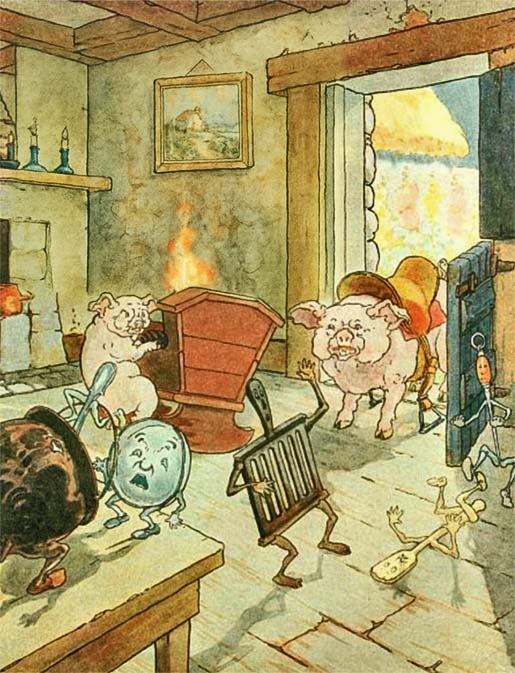The Sow Came in with the Saddle
The sow came in with the saddle,
The little pig rocked the cradle,
The dish jumped up on the table
To see the pot swallow the ladle.
The spit that stood behind the door
Threw the pudding-stick on the floor.
“Odsplut!” said the gridiron,
“Can’t you agree?
I'm the head constable,
Bring them to me!”

Origins
The Sow Came in with the Saddle grew out of the kind of nonsense people passed around long before books caught it. By the early 1800s, it had already found its way into printed Mother Goose collections, where it shows up almost exactly as we know it now. Families in Boston were reading it in The Only True Mother Goose Melodies in the 1830s, but it must have been circulating by word of mouth much earlier.
One clue is in that odd little shout, “Odsplut!” It looks strange to us, but it’s really just a softened oath — a polite way of saying “God’s blood!” By the time it appeared in nursery books, people weren’t using that expression anymore. That means the rhyme was carrying around a scrap of old folk language, preserved in children’s play long after it had vanished from everyday speech.
Meaning
This isn’t a moral tale — it’s a romp. A pig rocks a cradle, a dish jumps on the table, the pot swallows a ladle, and suddenly every object in the kitchen has a mind of its own. The humor comes from piling one absurdity on top of another until the gridiron, of all things, puffs up as “head constable” and declares order.
For children, the fun was in the rhythm and the ridiculousness. For adults, there might have been a knowing chuckle in the gridiron’s pompous voice — a parody of authority played out by a frying rack. Either way, the rhyme works as a tiny comedy skit in verse.
Nonsense rhymes like this were part of a much older tradition of turning the ordinary world upside down. Kitchen tools, farm animals, and household objects were familiar to every child. Giving them voices and quarrels made the rhyme instantly relatable and instantly funny.
It belongs in the same playful family as Hey Diddle Diddle [1] or Little King Boggen [2] — everyday things doing impossible things, told with a straight face. Victorian illustrators loved scenes like this, often sketching pigs in cradles and pots swallowing ladles with comic seriousness. To the reader, the fun was not only in the rhyme but in imagining the chaos erupting in their own kitchen.